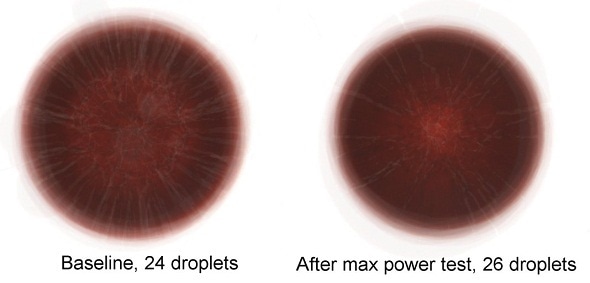Dried patterns and cracks from people’s blood droplets could indicate specific health conditions, new research suggests.

As part of a Nottingham Trent University study, scientists examined blood droplets of participants who took part in an exhaustive cycling exercise.
The research team took blood samples before the exercise and then again at various stages into recovery.
At every stage they deposited ten blood droplets from each volunteer onto glass – 1,800 droplets in total – allowing them to dry out naturally before photographing them.
As well as monitoring exercise-induced changes in participants’ blood chemistry, the researchers developed a machine learning algorithm capable of identifying statistically relevant correlations between the patterns in the droplets.
Along with an image processing routine, they were able to extract the most distinguishing features in the images and objectively discriminate between them.
The team found that by just analyzing the images of the blood droplets, the system was able to predict with 95% accuracy the different physical conditions of the volunteers and their stage of exhaustion or recovery.
The correlation is strongest when all ten images taken per volunteer per condition are averaged, rather than treated individually, the researchers found.
While researchers have previously attempted to search for distinguishing features in blood droplets through visual observation, it is the first time that quantitative and objective image analysis has been used.
The researchers say their approach has the potential to apply image processing and machine learning to accurately diagnose other health conditions, as well as healthy blood.
As the system analyses images using software and doesn’t rely on the equipment typically required to test blood samples, they say it would be capable of distinguishing conditions at a greater rate, faster, cheaper and more accurately.
Blood chemistry in the body starts to recover after a certain amount of time, but this doesn’t happen with the droplets.
The different ways in which blood dries and cracks form is to do with changes in the blood composition. Drying is a physical process so it will be affected by physical properties in the blood. For instance, if we look specifically at exhaustion, the blood becomes deoxygenated the more tired someone gets, the lactate concentration rises and we become dehydrated.
All of these factors will play a part in the drying process and pattern formation of the droplet.”
Dr. Dave Fairhurst, physicist in Nottingham Trent University’s School of Science and Technology
Dr. Lama Hamadeh added:
Blood has always been a key for diagnosing illnesses. The patterns left by dried blood droplets have been studied a lot qualitatively due to the rich patterns produced.
We now have evidence that images of droplets have a unique signature revealing the exhaustion level of an individual and our approach has great potential in providing a new, rapid and reliable method for other health conditions.”
The study – which involved physicists, sports scientists and mathematicians – is published in the journal Scientific Reports.
Source:
Journal reference:
Hamadeh, L., et al. (2020) Machine Learning Analysis for Quantitative Discrimination of Dried Blood Droplets. Scientific Reports. doi.org/10.1038/s41598-020-59847-x.